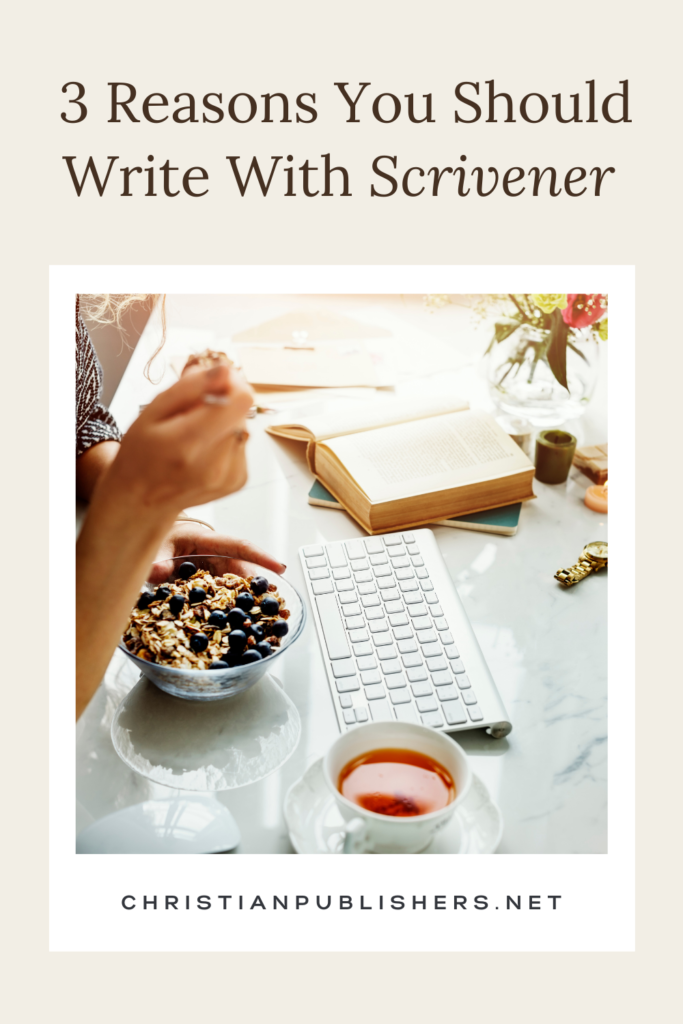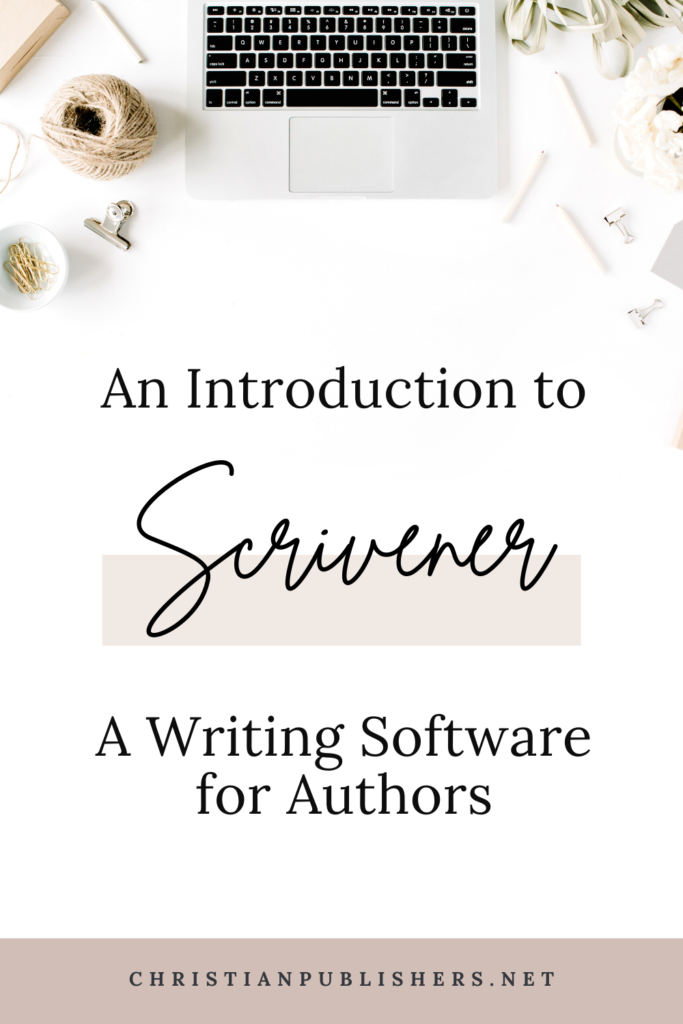
Beginner’s Guide to Using Scrivener: A Writing Software for Authors
As independent authors and writers, it’s easy to get into the weeds with our files, organization, and structures with our writing. One thing is clear, writing is hard work and we need all the help we can get to find our voice, get organized, and stay productive in our writing projects. For years, I’ve used a program called Scrivener. It’s a powerful writing software for authors I’ve found for many types of writing. It’s helped me stay organized and maintain an outline while I write. It allows me to review previous drafts all from one window, never having to leave the software.
I grew up reading book after book, drawn into the narrative the author weaved through the crisp pages of their newest novel. Often, my mother would encourage me to put the book down so that I could eat dinner. Today, I have an office filled with novels, teaching books, self-help titles, devotionals, and more. This love of reading created a deep desire to translate the message God put in my heart to the written page.
In 2010, I self-published my first novel, “Divine Providence.” But I had a problem while writing this novella. I kept losing pieces of my work while using Microsoft Word. Filling the computer screen sat several open file folders, drafts, research, and even character sketches. It became cumbersome to keep everything straight.
Then, at the zenith hour of finishing the final draft, I moved a single scene from one part of the book to a new spot, only to find I somehow erased hours of hard work, never to see it again. And because I had auto-save turned on, its digital footprint gone.
Have you had that frustration? Spending hours of work, only to find it gone in the blink of an eye? In 2009, I joined the Minnesota Christian Writer’s Guild, and a woman named Sue told me about a piece of software that revolutionized how I write today. That piece of software was Scrivener.
What is Scrivener & why should you use it?
Scrivener is a program written by writers for writers. It’s ease of use, simple design, and straight-forward approach allowed me to realize that it is easier than ever before to write faster and get more written in less time.
It’s never been more important than now to learn how to use this piece of software. Here are three powerful ways Scrivener by Literature and Latte will change your writing life.
1. Scrivener creates a powerful writing atmosphere.
Before I started using Scrivener, I used Microsoft Word. Now, there’s nothing wrong with Word. Despite its unappealing way of handling long-form text, I still use it daily for letters and other quick documents that need writing.
However, if you’re writing a 100,000 word novel, it’s easy to become lost in the weeds of endless pages, scrolling, and the inability to find what you’re looking for with a single keystroke. I’m sure you could set up several macros and other functionality, but who has the time to develop Word into their personal powerhouse?
Scrivener allows you to easily organize your files into something akin to a digital 3-ring binder filled with folders, pages, sections, and more, all without having to leave your software. In fact, I have several windows open as I write, all without feeling like it’s cluttered. Here’s my basic structure set up in the binder window within Scrivener:
- Manuscript – This folder is where I do the main writing.
- Chapter file
- Scene file
- Scene file
- Chapter file
- Chapter file
- Style Guide – This folder is easy to access while writing a chapter, and I can quickly look up something to keep my writing consistent.
- Character Sketche file
- Character 1 file
- Character 2 file
- Location Sketches file
- Location 1 file
- Location 2 file
- Character Sketche file
- Research Folder
- Notes – I can create notes and store them here for quick access
- Webpages – I can open webpages within the software and not have to open Chrome.
- Misc – Anything else I find valuable.
- Trash – self-explanatory
2. Scrivener helps you write distraction free.
Author Robin Sharma said in a tweet in 2014, “An addiction to distraction is the death of creative production.” The moment we’re locked into what we’re writing, we pick up the phone, checking our favorite social media accounts, and next thing we know, several minutes to an hour has gone by with nothing to show for our attempt at writing our next indie novel. We become distracted from our task at hand.
This is where Scrivener shines. Yes, as I said above, it’s easy to have multiple windows open on Scrivener, but there’s a neat little button called, “Compose” mode. This mode allows you to write distraction-free. It turns off everything on your desktop and opens up a single page, with zero other windows or even formatting buttons, to write your masterpiece.
I’ve found that using this composition window and using the Pomodoro technique, I wrote 84,000 words in just 30 days!
3. Scrivener is a powerful book exporting tool.
For the independent author, self-publishing is a ton of hard work and, to boot, expensive. This is one of the most powerful features that Scrivener can help the fledging author with saving money. After your work is complete, and you’re ready to publish, there’s an exporting tool that helps you create the exact type of file you need.
What features do they include with Scrivener?
- If you’re sending to an agent, you can export a formatted manuscript in Microsoft Word format.
- If you’re using Vellum to typeset your print and ebooks, it exports Vellum import-ready documents.
- If you just want a PDF for print, you can export it as a print-ready book, or a typeset for Amazon KDP and IngramSpark.
- If you are publishing an ebook, Scrivener allows you to export as a .mobi or .epub version for upload into the KDP store or Draft2Digital.
This piece of software has changed my writing life. I’m just about to publish my seventh book, using this piece of software to help me get the manuscript written and ready for publication. Because I love this software so much, I’ve opened the doors to a 5-week Zoom class on how you can use this software to write your next masterpiece.
This course will teach you not only the basics but will also help you go from blank page to ready to print manuscript. I’m offering all CIPA members a 10 percent discount for this course. But act fast as the doors will close on June 7, 2021.
Are you ready to take the plunge into using this piece of software? Take a peek at what is inside this course.
Author Bio:
Jason Sisam is an author, professional blogger, and pastor. He helps motivate leaders and writers so they are equipped to find their voice, write their stories, and succeed in their family, ministry, and life. Jason serves as Operation’s Pastor of Christian Family Church (Formerly Life Church). He is also the President of the Minnesota Christian Writers Guild. He has written several books that connect with the heart and delivers stories that resonate with truth. Jason lives in Minneapolis with his wife, Kari, and their two children. You can find Jason at https://jasonsisam.com.




